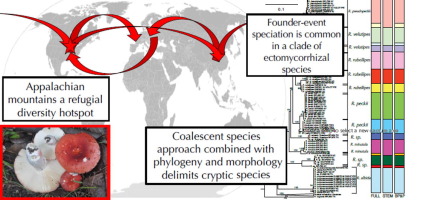当前位置:
X-MOL 学术
›
Mol. Phylogenet. Evol.
›
论文详情
Our official English website, www.x-mol.net, welcomes your feedback! (Note: you will need to create a separate account there.)
Coalescent-based delimitation and species-tree estimations reveal Appalachian origin and Neogene diversification in Russula subsection Roseinae.
Molecular Phylogenetics and Evolution ( IF 4.1 ) Pub Date : 2020-03-09 , DOI: 10.1016/j.ympev.2020.106787 Brian P Looney 1 , Slavomír Adamčík 2 , P Brandon Matheny 1
Molecular Phylogenetics and Evolution ( IF 4.1 ) Pub Date : 2020-03-09 , DOI: 10.1016/j.ympev.2020.106787 Brian P Looney 1 , Slavomír Adamčík 2 , P Brandon Matheny 1
Affiliation

|
Numerous lineages of mushroom-forming fungi have been subject to bursts of diversification throughout their evolutionary history, events that can impact our ability to infer well-resolved phylogenies. However, groups that have undergone quick genetic change may have the highest adaptive potential. As the second largest genus of mushroom-forming fungi, Russula provides an excellent model for studying hyper-diversification and processes in evolution that drives it. This study focuses on the morphologically defined group - Russula subsection Roseinae. Species hypotheses based on morphological differentiation and multi-locus phylogenetic analyses are tested in the Roseinae using different applications of the multi-species coalescent model. Based on this combined approach, we recognize fourteen species in Roseinae including the Albida and wholly novel Magnarosea clades. Reconstruction of biogeographic and host association history suggest that parapatric speciation in refugia during glacial cycles of the Pleistocene drove diversification within the Roseinae, which is found to have a Laurasian distribution with an evolutionary origin in the Appalachian Mountains of eastern North America. Finally, we detect jump dispersal at a continental scale that has driven diversification since the most recent glacial cycles.
中文翻译:

基于聚结的定界和物种树估计揭示了Russula分区Rosinae中的阿巴拉契亚起源和新近纪多样化。
蘑菇形成真菌的许多谱系在其整个进化历史中都经历了多样化的爆发,这些事件会影响我们推断良好解析的系统发育的能力。但是,经历了快速遗传改变的群体可能具有最高的适应潜力。作为蘑菇形成真菌的第二大属,红菇为研究超多样化和驱动它的进化过程提供了一个极好的模型。这项研究的重点是在形态学上定义的组-Russula小节Roseinae。使用多物种合并模型的不同应用,在Roseinae中测试了基于形态分化和多位点系统发育分析的物种假设。基于这种组合方法,我们认识到Roseinae中的14个物种,包括Albida和全新的Magnarosea进化枝。生物地理学和寄主协会历史的重建表明,在更新世的冰川周期,避难所中的准亲缘物种形成推动了Roseinae内的多样化,而Roseinae被发现具有劳拉斯分布,并且起源于北美东部的阿巴拉契亚山脉。最后,自最近的冰川周期以来,我们在大陆尺度上检测到了跳跃扩散,从而推动了其多样化。它被发现具有劳拉斯分布,并在北美东部的阿巴拉契亚山脉中具有演化起源。最后,自最近的冰川周期以来,我们在大陆尺度上检测到了跳跃扩散,从而推动了其多样化。它被发现具有劳拉斯分布,并在北美东部的阿巴拉契亚山脉中具有演化起源。最后,自最近的冰川周期以来,我们在大陆尺度上检测到了跳跃扩散,从而推动了其多样化。
更新日期:2020-03-09
中文翻译:

基于聚结的定界和物种树估计揭示了Russula分区Rosinae中的阿巴拉契亚起源和新近纪多样化。
蘑菇形成真菌的许多谱系在其整个进化历史中都经历了多样化的爆发,这些事件会影响我们推断良好解析的系统发育的能力。但是,经历了快速遗传改变的群体可能具有最高的适应潜力。作为蘑菇形成真菌的第二大属,红菇为研究超多样化和驱动它的进化过程提供了一个极好的模型。这项研究的重点是在形态学上定义的组-Russula小节Roseinae。使用多物种合并模型的不同应用,在Roseinae中测试了基于形态分化和多位点系统发育分析的物种假设。基于这种组合方法,我们认识到Roseinae中的14个物种,包括Albida和全新的Magnarosea进化枝。生物地理学和寄主协会历史的重建表明,在更新世的冰川周期,避难所中的准亲缘物种形成推动了Roseinae内的多样化,而Roseinae被发现具有劳拉斯分布,并且起源于北美东部的阿巴拉契亚山脉。最后,自最近的冰川周期以来,我们在大陆尺度上检测到了跳跃扩散,从而推动了其多样化。它被发现具有劳拉斯分布,并在北美东部的阿巴拉契亚山脉中具有演化起源。最后,自最近的冰川周期以来,我们在大陆尺度上检测到了跳跃扩散,从而推动了其多样化。它被发现具有劳拉斯分布,并在北美东部的阿巴拉契亚山脉中具有演化起源。最后,自最近的冰川周期以来,我们在大陆尺度上检测到了跳跃扩散,从而推动了其多样化。



























 京公网安备 11010802027423号
京公网安备 11010802027423号